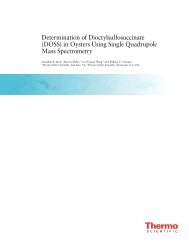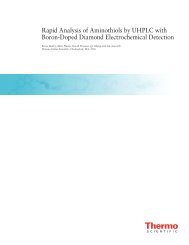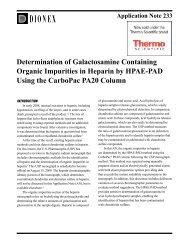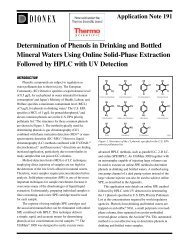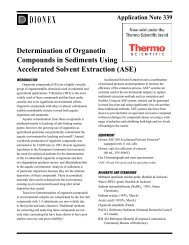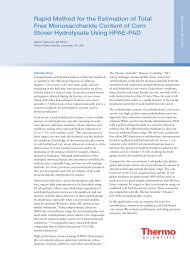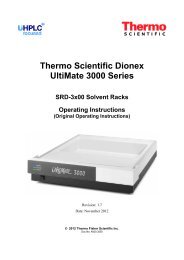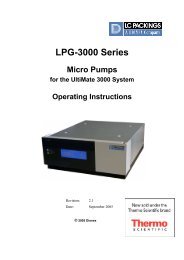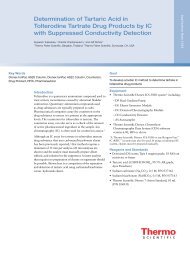AN96: Determination of N-Methylcarbamates by Reversed ... - Dionex
AN96: Determination of N-Methylcarbamates by Reversed ... - Dionex
AN96: Determination of N-Methylcarbamates by Reversed ... - Dionex
Create successful ePaper yourself
Turn your PDF publications into a flip-book with our unique Google optimized e-Paper software.
<strong>Determination</strong> <strong>of</strong> N-<strong>Methylcarbamates</strong><br />
<strong>by</strong> <strong>Reversed</strong>-Phase HPLC<br />
INTRODUCTION<br />
N-methylcarbamates and N-methylcarbamoyloximes<br />
are among the most widely used pesticides in the<br />
world. U.S. EPA method 531.2 provides guidelines for<br />
monitoring these compounds in ground and surface<br />
waters as well as drinking water. 1 <strong>Reversed</strong>-Phase High<br />
Performance Liquid Chromatography (RP-HPLC) is<br />
the preferred method for separating carbamates. Most<br />
alternate methods for analysis have significant limitations.<br />
Gas chromatographic analysis has proven unsuccessful<br />
due to degradation <strong>of</strong> the analyte compounds<br />
during vaporization. HPLC with UV detection does not<br />
<strong>of</strong>fer the sensitivity or specificity required for the sample<br />
matrices <strong>of</strong> interest. HPLC with positive mode electrospray<br />
ionization mass spectrometry has been shown to<br />
be a promising alternative, but it increases the expense<br />
and expertise required for the analysis.<br />
Postcolumn derivatization with fluorescence detection<br />
after a reversed-phase HPLC separation is consistent<br />
with U.S. EPA Method 531.2. This method delivers<br />
highly sensitive determinations <strong>of</strong> carbamate compounds.<br />
Application Note 96<br />
SUmmaRy Of ChROmaTOgRaphIC meThOD<br />
After direct injection <strong>of</strong> the sample onto the HPLC<br />
column, carbamates are separated using a water/<br />
methanol/acetonitrile gradient. After separation, they pass<br />
through a postcolumn reaction system where they are<br />
derivatized with a fluorescent reagent, then quantified using<br />
fluorescence detection. The Acclaim ® 120 C18 column<br />
provides reliable separation <strong>of</strong> the analyte compounds. The<br />
reagents specified are quality controlled <strong>by</strong> the manufacturer<br />
to ensure minimal background interference.<br />
INSTRUmeNTaTION<br />
<strong>Dionex</strong> Summit ® HPLC system* consisting <strong>of</strong>:<br />
DPG-680 Dual Pump<br />
ASI-100 Automated Sample Injector<br />
TCC-100 Thermostatted Column Compartment<br />
RF-2000 Fluorescence Detector<br />
Chromeleon ® 6.80 Chromatography Workstation<br />
Pickering PCX 5200 Derivatization Instrument<br />
*This application can also be performed on an<br />
UltiMate ® 3000 HPLC with the following components:<br />
DPG 3600A Dual Pump SRD 3600<br />
WPS-3000TSL Automated sample injector<br />
TCC-3200 Thermostatted Column Compartment<br />
RF-2000 Fluorescence Detector<br />
Application Note 96 1
ReageNTS aND STaNDaRDS<br />
Water, Milli-Q water from Milli-Q Gradient A10<br />
Methanol (CH 3 OH), Fisher, HPLC grade<br />
Acetonitrile (CH 3 CN), Fisher, HPLC grade<br />
Potassium dihydrogen citrate (KC 6 H 7 O 7 ), Fluka, ≥ 98%<br />
Sodium thiosulfate (Na 2 S 2 O 3 ), Fluka, ≥ 98%<br />
Hydrolysis Reagent (0.2% NaOH), Pickering,<br />
chromatographic grade (P/N CB130)<br />
o-Phthalaldehyde (OPA, C 8 H 6 O 2 ), Pickering,<br />
chromatographic grade, (P/N O120)<br />
OPA Diluent (0.4% sodium borate solution), Pickering,<br />
chromatographic grade (P/N CB910)<br />
Mercaptan Reagent, (Thi<strong>of</strong>luor (CH 3 ) 2 NCH 2 CH 2 SH•HCl),<br />
Pickering, chromatographic grade (P/N 3700-2000)<br />
531.2 Carbamate Pesticide Calibration Mixture, Restek,<br />
100 µg/mL (P/N 257974)<br />
4-Bromo-3, 5-dimethylphenyl-N-methylcarbamate<br />
standard, Restek, 100 µg/mL (P/N 32274)<br />
pRepaRaTION Of ReageNTS aND STaNDaRDS<br />
Reagent WaterStock Standard Solutions<br />
Deionized water, Type I reagent grade, 18 MΩ-cm<br />
resistivity or better<br />
Preserved Reagent Water<br />
Dissolve 4.7 g potassium dihydrogen citrate and<br />
160 mg Na 2 S 2 O 3 in a 50 mL beaker with reagent water,<br />
transfer this solution to a 500 mL volumetric flask and<br />
bring to volume with reagent water. Prior to use, filter the<br />
solution through a 0.45-µm filter.<br />
Stock Standard Solutions <strong>of</strong> Carbamate Pesticide<br />
Calibration Mixture<br />
Pipet 10 µL and 100 µL 531.2 carbamate pesticide<br />
calibration mixture (100 µg/mL) into two 1 mL vials, add<br />
990 µL to vial one and 900 µL methanol to vial two. The<br />
concentrations <strong>of</strong> stock standard solutions <strong>of</strong> the calibration<br />
mixture are 1.0 µg/mL and 10 µg/mL, respectively.<br />
Stock Standard Solution <strong>of</strong> 4-Bromo-3,5-dimethyl-<br />
phenyl-N-methylcarbamate Standard (Surrogate Analyte,<br />
SUR)<br />
Pipet 100 µL 4-bromo-3, 5-dimethylphenyl-N-methylcarbamate<br />
standard (100 µg/mL) into a 1 mL vial, and<br />
add 900 µL methanol. The concentration <strong>of</strong> the stock<br />
standard solution <strong>of</strong> the standard is 10 µg/mL.<br />
2 <strong>Determination</strong> <strong>of</strong> N-<strong>Methylcarbamates</strong> <strong>by</strong> <strong>Reversed</strong>-Phased HPLC<br />
Table 1: Preparation <strong>of</strong> calibration curve standards<br />
Stock std.<br />
<strong>of</strong> carbamate<br />
cal. mixture<br />
(µg/mL)<br />
Vol. <strong>of</strong> stock<br />
std. <strong>of</strong><br />
carbamate<br />
cal. mixture<br />
(µL)<br />
Vol. <strong>of</strong> 10<br />
µg/mL stock<br />
std. <strong>of</strong> SUR<br />
(µL)<br />
Final vol.<br />
<strong>of</strong> cal.<br />
std. (mL)<br />
Final conc.<br />
<strong>of</strong> cal. std.<br />
(µg/L)<br />
Final conc.<br />
<strong>of</strong> SUR<br />
(µg/L)<br />
1.0 5.0 5.0 25 0.20 2.00<br />
1.0 12.5 5.0 25 0.50 2.00<br />
1.0 25.0 5.0 25 1.00 2.00<br />
10.0 5.0 5.0 25 2.00 2.00<br />
10.0 12.5 5.0 25 5.00 2.00<br />
10.0 25.0 5.0 25 10.0 2.00<br />
Working Standard Solutions<br />
Prepare six working standard solutions <strong>by</strong> adding the<br />
quantities <strong>of</strong> carbamate mixture stock standard solutions<br />
listed in Table 1 to separate 25 mL volumetric flasks.<br />
Add 5 µL <strong>of</strong> the stock standard solution <strong>of</strong> 4-bromo-3,<br />
5-dimethylphenyl-N-methylcarbamate into each flask.<br />
Bring to volume with preserved reagent water.<br />
Sodium Hydroxide Hydrolysis Reagent<br />
(Post Column Reagent 1)<br />
Decant the hydrolysis reagent into a clean reagent<br />
reservoir that has been rinsed with methanol. Because<br />
high-purity sodium hydroxide is difficult to purchase as<br />
well as prepare, we strongly recommend the use <strong>of</strong> this<br />
reagent for optimum system performance. This reagent<br />
also contains an antifouling additive to prevent mineral<br />
buildup inside the reactor.<br />
OPA Reagent (Postcolumn Reagent 2)<br />
Decant the contents <strong>of</strong> the OPA diluent into a clean<br />
reagent bottle that has been rinsed with methanol. Sparge<br />
the diluent for approximately 10 min to remove oxygen.<br />
Note: The remaining steps should be accomplished<br />
quickly because the prepared reagents are sensitive to<br />
oxygen and light. Weigh approximately 100 mg <strong>of</strong><br />
o-phthalaldehyde into a small beaker, dissolve in 10 mL<br />
methanol, and add to the OPA diluent. Rinse the beaker<br />
with 1 to 2 mL <strong>of</strong> methanol and add this to the diluent.<br />
Add 2 g <strong>of</strong> Thi<strong>of</strong>luor to the reagent bottle, replace the cap,<br />
and sparge for 1 to 2 min. Swirl the bottle gently to<br />
ensure complete mixing.<br />
Tap Water Sample Preparation<br />
The tap water sample was obtained at the <strong>Dionex</strong><br />
(Shanghai) Application Lab located in the Pudong<br />
District, Shanghai, China.
Place 2.32 g potassium dihydrogen citrate and 80 mg<br />
Na 2 S 2 O 3 in a 500 mL beaker, then add approximately<br />
250 mL tap water and mix. The treated tap water sample<br />
should be stored in the dark at -10°C until analyzed. Prior<br />
to use, filter through a 0.45-µm filter.<br />
CONDITIONS<br />
Column: Acclaim ® 120 C18, 3 µm,<br />
4.6 × 150 mm (P/N 059133)<br />
Column temperature: 42 °C<br />
Mobile phase:<br />
Gradient:<br />
A: water, B: acetonitrile,<br />
C: methanol<br />
Time (min) A (%) B (%) C (%) Curve<br />
0.0 85 0 15<br />
3.0 85 0 15 5<br />
14.0 60 20 20 1<br />
15.3 40 30 30 5<br />
21.0 40 30 30 5<br />
22.0 85 0 15 5<br />
30.0 85 0 15 5<br />
Restrictor 2<br />
Anti-siphon<br />
valve<br />
Mixing<br />
Tee<br />
Bypass 2<br />
Restrictor 1<br />
Post-Column<br />
Press. Gauge<br />
Heated<br />
Reactor<br />
500 µL<br />
Ambient<br />
Reactor<br />
100 µL<br />
RF2000<br />
Bypass 1<br />
Anti-siphon<br />
valve<br />
Mixing Tee<br />
0.69 MPa<br />
(100 psi B.P.)<br />
Reagent 1<br />
Pressure Gauge<br />
Reagent Pump<br />
Reagent 2<br />
Pressure Gauge<br />
1 2 NaOH OPA<br />
Thermostatted Column<br />
3.45 MPa<br />
(500 psi)<br />
Pressure Switch<br />
Flow rate: 1.0 mL/min<br />
Injection volume: 250 µL<br />
Post column reagent 1: 0.2% sodium hydroxide,<br />
first reaction coil at 100 °C<br />
Flow rate <strong>of</strong> reagent 1: 0.3 mL/min<br />
Post column reagent 2: OPA reagent, second<br />
reaction coil at ambient<br />
temperature<br />
Flow rate <strong>of</strong> reagent 2: 0.3 mL/min<br />
Fluorescence: Excitation: 330 nm<br />
Emission: 465 nm<br />
Response: 2 (0.5 s)<br />
Sensitivity: 2 (medium)<br />
Gain: 1 (×1)<br />
4.1 MPa<br />
Injector<br />
(600 psi)<br />
Over-pressure<br />
Waste<br />
relief<br />
P680<br />
Water/Methanol/MeCN}<br />
24083<br />
ReSULTS aND DISCUSSION<br />
Postcolumn Chemistry<br />
The postcolumn system features two reagent pumps,<br />
two reactors (one heated), and a column oven. A built-in<br />
pressure switch will shut down the reagent pumps when<br />
it senses that the analytical pump pressure has dropped<br />
below 3.4 Mpa (500 Psi). This feature prevents backflow<br />
<strong>of</strong> sodium hydroxide onto the analytical column when<br />
the analytical pump fails to pump or deliver mobile<br />
phase. A schematic diagram<br />
<strong>of</strong> the system hardware is<br />
shown in Figure 1.<br />
Pre-Column<br />
Filter<br />
Figure 1. Schematic <strong>of</strong> carbamate analysis system setup. The chromatography column and postcolumn<br />
reactor system are represented <strong>by</strong> the portion <strong>of</strong> diagram inside the dotted line.<br />
Application Note 96 3
RO<br />
OPA<br />
O<br />
N<br />
H<br />
Carbamate<br />
CHO<br />
CHO<br />
CH 3<br />
+<br />
+<br />
H 2 O<br />
OH -<br />
100 ° C<br />
(CH 3 ) 2 NCH 2 CH 2 SH<br />
CH 3 NH 2<br />
pH ≥ 9<br />
2<br />
CH 3 NH 2 + R – OH + CO<br />
3<br />
-<br />
SCH 2 CH 2 N(CH 3 ) 2<br />
N — CH 3<br />
Fluorescent isoindole<br />
Figure 2. Postcolumn reaction chemistry <strong>of</strong> carbamate.<br />
After separation on the C18 column, carbamates are<br />
hydrolyzed <strong>by</strong> sodium hydroxide at 100° C. The resulting<br />
methylamines are then reacted with o-phthalaldehyde<br />
and N, N’-dimethyl-2-mercaptoethylamine hydrochloride<br />
(Thi<strong>of</strong>luor) to form a fluorescent isoindole compound.<br />
The details <strong>of</strong> this chemistry are shown in Figure 2.<br />
Note: The Thi<strong>of</strong>luor reagent replaces 2-mercaptoethanol,<br />
a reagent sometimes used for this application.<br />
The advantage <strong>of</strong> using Thi<strong>of</strong>luor is that it is more stable<br />
and relatively odorless.<br />
To assist in troubleshooting postcolumn chemistry<br />
issues, 1-naphthol is included in some standard<br />
carbamate mixtures, as shown in Figure 3 (peak 10).<br />
This compound is naturally fluorescent; therefore it will<br />
be the only peak present in a chromatogram when the<br />
postcolumn system is not functioning properly.<br />
Resolution and Reproducibility<br />
Figure 3 illustrates good separation <strong>of</strong> the carbamates<br />
listed in U. S. EPA Method 531.2 using the<br />
Acclaim 120 C18. Resolution for all peaks is much better<br />
than the values required in the EPA Method (≥ 1.0).<br />
Reproducibility was estimated <strong>by</strong> making 7 replicate<br />
injections <strong>of</strong> a calibration standard with concentration<br />
<strong>of</strong> 1.0 µg/L. The values <strong>of</strong> relative standard deviation<br />
(RSD) <strong>of</strong> each carbamate for retention time and for peak<br />
area are listed in Table 2.<br />
Column: Acclaim 120 C18,<br />
4.6 mm x 150 mm<br />
Eluent: CH3CN/CH3OH/<br />
H 2O: Gradient<br />
Temperature: 42 °C<br />
Flow Rate: 1.0 mL/min<br />
Inj. Volume: 250 µL<br />
Detection: RF-2000<br />
Excitation: 330 nm;<br />
Emission: 465 nm<br />
4 <strong>Determination</strong> <strong>of</strong> N-<strong>Methylcarbamates</strong> <strong>by</strong> <strong>Reversed</strong>-Phased HPLC<br />
24084<br />
35.4<br />
mV<br />
1<br />
23<br />
4<br />
–14.9<br />
5.4 7.5 10 12.5 15 17.5 20 22.5 25 27.2<br />
Table 2: Reproducibility <strong>of</strong> retention time and peak<br />
areas for ten carbamates and two reference components<br />
Carbamates<br />
Aldicarb sulfoxide<br />
Aldicarb sulfone<br />
Oxamyl<br />
Methomyl<br />
3-Hydroxycarb<strong>of</strong>uran<br />
Aldicarb<br />
Propoxur<br />
Carb<strong>of</strong>uran<br />
Carbaryl<br />
1-Naphthol<br />
Methiocarb<br />
5<br />
6<br />
20<br />
20<br />
30<br />
30<br />
Peaks: 1. Aldicarb sulfoxide 2 µg/L<br />
2. Aldicarb sulfone 2<br />
3. Oxamyl 2<br />
4. Methomyl 2<br />
5. 3-Hydroxy carb<strong>of</strong>uran 2<br />
6. Aldicarb 2<br />
7. Propoxur 2<br />
8. Carb<strong>of</strong>uran 2<br />
9. Carbaryl 2<br />
10. 1-Naphthol 2<br />
11. Methiocarb 2<br />
12. BDMC 2<br />
7 8<br />
Minutes<br />
9<br />
10<br />
Retention Time RSD (%) Peak Area RSD (%)<br />
0.11 3.09<br />
0.08 1.39<br />
0.08 1.04<br />
0.06 0.99<br />
0.06 1.39<br />
0.05 1.06<br />
0.07 2.04<br />
0.08 2.98<br />
0.04 0.83<br />
0.03 0.79<br />
0.03 2.78<br />
15<br />
11 12<br />
Figure 3. Standard mixture <strong>of</strong> 10 carbamates (2 µg/L) plus two<br />
reference compounds (peaks 10 and 12) with 250 µL injection.<br />
0<br />
24085
Column: Acclaim 120 C18,<br />
4.6 mm x 150 mm<br />
Eluent: CH3CN/CH 3OH/<br />
H 2O: Gradient<br />
Temperature: 42 °C<br />
Flow Rate: 1.0 mL/min<br />
Inj. Volume: 250 µL<br />
Detection: RF-2000<br />
Excitation: 330 nm;<br />
Emission: 465 nm<br />
22.3<br />
mV<br />
Peaks: 1. Aldicarb sulfoxide<br />
2. Aldicarb sulfone<br />
3. Oxamyl<br />
4. Methomyl<br />
5. 3-Hydroxy carb<strong>of</strong>uran<br />
6. Aldicarb<br />
7. Propoxur<br />
8. Carb<strong>of</strong>uran<br />
9. Carbaryl<br />
10. 1-Naphthol<br />
11. Methiocarb<br />
–14.3<br />
4 6 8 10 12 14 16 18 20 22 24<br />
140<br />
B<br />
4<br />
9<br />
mV<br />
A<br />
1<br />
1.0 µg/L<br />
0.5 µg/L<br />
0.2 µg/L<br />
10 µg/L<br />
5 µg/L<br />
2 µg/L<br />
2 3<br />
1<br />
4<br />
23<br />
5<br />
6<br />
5 6<br />
9<br />
10<br />
–51<br />
3.3 6 8 10 12 14 16 18 20 22 24<br />
Minutes<br />
24086<br />
Figure 4. An overlay <strong>of</strong> chromatograpms <strong>of</strong> carbamates with<br />
concentrations <strong>of</strong> (A) 0.2, 0.5 and 1.0 µg/L, respectively;<br />
and (B) 2.0, 5.0 and 10 µg/L.<br />
Linearity and Detection Limits<br />
Figure 4 shows an overlay <strong>of</strong> chromatograms <strong>of</strong><br />
the serial standard solutions <strong>of</strong> carbamates. Calibration<br />
linearity for the determination <strong>of</strong> carbamates <strong>by</strong> this<br />
method was investigated <strong>by</strong> making replicate injections<br />
(n = 7) <strong>of</strong> serial standard solutions <strong>of</strong> carbamates at six<br />
different concentrations. Detection limits <strong>of</strong> carbamates<br />
were calculated <strong>by</strong> using the equation found in<br />
EPA 531.1 and 531.2:<br />
Detection limit = St (n – 1, 1 - α = 0.99)<br />
Where:<br />
S = standard deviation <strong>of</strong> replicate analyses<br />
t (n – 1, 1 - α = 0.99) = Student’s value for the 99%<br />
confidence level with n -1 degrees <strong>of</strong> freedom,<br />
n = number <strong>of</strong> replicates<br />
7 8<br />
7 8<br />
10<br />
11<br />
11<br />
Carbamates<br />
Aldicarb sulfoxide<br />
Aldicarb sulfone<br />
Oxamyl<br />
Methomyl<br />
3-Hydroxycarb<strong>of</strong>uran<br />
Aldicarb<br />
Propoxur<br />
Carb<strong>of</strong>uran<br />
Carbaryl<br />
Methiocarb<br />
Table 3: Method linearity data<br />
and method detection limits (MDL)<br />
Correlation<br />
coefficient (R)<br />
* When n = 10, t (n – 1, 1 - α = 0.99) = 3.17<br />
Carbamates Detected<br />
(µg/L)<br />
Aldicarb sulfoxide<br />
Aldicarb sulfone<br />
Oxamyl<br />
Methomyl<br />
3-Hydroxycarb<strong>of</strong>uran<br />
Aldicarb<br />
Propoxur<br />
Carb<strong>of</strong>uran<br />
Carbaryl<br />
1-Naphthol<br />
Methiocarb<br />
Method<br />
531.1 MDL<br />
requirements<br />
(µg/L)<br />
Method<br />
531.1 MDL<br />
(µg/L)<br />
<strong>Dionex</strong><br />
Method<br />
MDL (µg/L)<br />
0.9992 2.0 0.59 0.018<br />
0.9995 2.0 1.00 0.046<br />
0.9994 2.0 0.86 0.035<br />
0.9995 0.5 0.29 0.028<br />
0.9994 2.0 1.90 0.036<br />
0.9995 1.0 0.22 0.032<br />
0.9994 1.0 1.00 0.031<br />
0.9993 1.5 0.52 0.059<br />
0.9995 2.0 1.30 0.026<br />
0.9993 4.0 1.90 0.041<br />
Table 4: Tap water sample analysis<br />
Added 1<br />
(µg/L)<br />
Found RSD Recovery<br />
(µg/L) (%) (%)<br />
Added 2<br />
(µg/L)<br />
Found<br />
(µg/L)<br />
RSD Recovery<br />
(%) (%)<br />
0.0 0.20 0.20 6.25 102 10.00 10.66 4.14 107<br />
0.0 0.20 0.21 8.42 103 10.00 10.65 4.60 107<br />
0.0 0.20 0.19 13.4 93 10.00 10.60 4.52 106<br />
0.0 0.20 0.18 5.11 92 10.00 10.88 4.61 109<br />
0.0 0.20 0.19 4.25 94 10.00 10.46 4.43 105<br />
0.0 0.20 0.18 6.16 88 10.00 10.88 4.30 109<br />
0.0 0.20 0.19 6.92 92 10.00 10.56 4.67 106<br />
0.0 0.20 0.21 8.11 103 10.00 10.60 4.78 106<br />
0.0 0.20 0.17 6.28 87 10.00 10.54 4.85 105<br />
0.0 0.20 0.20 4.47 99 10.00 10.22 4.52 102<br />
0.0 0.20 0.20 4.82 100 10.00 10.46 4.80 105<br />
Ten replicate injections <strong>of</strong> reagent water fortified<br />
with 0.2 µg/L carbamate standard were used in<br />
this method. Table 3 summarizes the data, which show<br />
excellent method linearity and sensitivity, with detection<br />
limits well below those defined in the EPA method.<br />
(The improved detection limits are largely due to improvements<br />
in fluorescence detector sensitivity and<br />
reversed-phase column technology since the original<br />
EPA work was completed. The EPA method used a 5 µm<br />
4.6 x 250 mm column while this method used a 3 µm<br />
4.6 x 150 mm column to yield more efficient peaks.)<br />
These improved limits easily allow the analyst to reach<br />
the minimum reporting limits (3-5 times the MDL) <strong>of</strong><br />
the original method.<br />
Application Note 96 5
Column: Acclaim 120 C18,<br />
4.6 mm x 150 mm<br />
Eluent: CH3CN/CH3OH/<br />
H 2O: Gradient<br />
Temperature: 42 °C<br />
Flow Rate: 1.0 mL/min<br />
Inj. Volume: 250 µL<br />
Detection: RF-2000<br />
Excitation: 330 nm;<br />
Emission: 465 nm<br />
5.5<br />
mV<br />
–8.5<br />
8.8<br />
mV<br />
–6.6<br />
180<br />
A<br />
B<br />
C<br />
23<br />
1<br />
4<br />
A B C<br />
Peaks: 1. Aldicarb sulfoxide 0 0.2 10 µg/L<br />
2. Aldicarb sulfone 0 0.2 10<br />
3. Oxamyl 0 0.2 10<br />
4. Methomyl 0 0.2 10<br />
5. 3-Hydroxy carb<strong>of</strong>uran 0 0.2 10<br />
6. Aldicarb 0 0.2 10<br />
7. Propoxur 0 0.2 10<br />
8. Carb<strong>of</strong>uran 0 0.2 10<br />
9. Carbaryl 0 0.2 10<br />
10. 1-Naphthol 0 0.2 10<br />
11. Methiocarb<br />
12. BDMC<br />
0 0.2 10<br />
5 6 78<br />
Minutes<br />
12<br />
9<br />
10 11<br />
mV<br />
1<br />
–20<br />
0 2 4 6 8 10 12 14 16 18 20 22 24 26 28 30<br />
23<br />
4<br />
5 6<br />
78<br />
9<br />
10<br />
11<br />
12<br />
Figure 5. Chromatograms (A) a tap water sample, (B) tap water<br />
(A) + 0.2 µg/L carbamate standard mix (C) tap water (A) +<br />
10 µg/L carbamate standard mix.<br />
Tap Water Sample Analysis<br />
Figure 5 compares the chromatograms <strong>of</strong> an unadulterated<br />
tap water sample with two samples spiked with<br />
0.2 µg/L and 10 µg/L carbamate standards. No detectable<br />
levels <strong>of</strong> carbamates were found in the tap water. The<br />
related data are summarized in Table 4. This data shows<br />
excellent spike recovery for each carbamate compound.<br />
Column: Acclaim 120 C18,<br />
4.6 mm x 150 mm<br />
Eluent: CH3CN/CH3OH/<br />
H 2O: Gradient<br />
Temperature: 42 °C<br />
Flow Rate: 1.0 mL/min<br />
Inj. Volume: 250 µL (A)<br />
100 µL (B)<br />
Detection: RF-2000<br />
Excitation: 330 nm;<br />
Emission: 465 nm<br />
6 <strong>Determination</strong> <strong>of</strong> N-<strong>Methylcarbamates</strong> <strong>by</strong> <strong>Reversed</strong>-Phased HPLC<br />
24087<br />
100<br />
mV<br />
Peaks: 1. Aldicarb sulfoxide 10 µg/L<br />
2. Aldicarb sulfone 10<br />
3. Oxamyl 10<br />
4. Methomyl 10<br />
5. 3-Hydroxy carb<strong>of</strong>uran 10<br />
6. Aldicarb 10<br />
7. Propoxur 10<br />
8. Carb<strong>of</strong>uran 10<br />
9. Carbaryl 10<br />
10. 1-Naphthol 10<br />
11. Methiocarb 10<br />
12. BDMC 10<br />
-10<br />
5 6.3 7.5 8.8 10 11.3 12.5 14 15 16.3 17.5 18.8 20 21.3 22.5 23.8<br />
60<br />
mV<br />
A<br />
B<br />
1<br />
1<br />
2 3<br />
2 3<br />
4<br />
4<br />
5<br />
5<br />
6<br />
6<br />
20<br />
20<br />
-5.9<br />
5 6.3 7.5 8.8 10 11.3 12.5 14 15 16.3 17.5 18.8 20 21.3 22.5 23.8<br />
Minutes<br />
30<br />
30<br />
7 8<br />
7 8<br />
9<br />
10<br />
9 10<br />
11<br />
15<br />
0<br />
12<br />
11 12<br />
Figure 6. Chromatograms <strong>of</strong> a standard mixture <strong>of</strong> 10 carbamates<br />
(2.5 µg/mL) plus two reference compounds (peaks 10 and 12)<br />
on (A) Summit and (B) UltiMate Systems, respectively, under the<br />
same chromatographic condition except for injection volume,<br />
(A) 250 µL and (B) 100 µL.<br />
Chromatography with the UltiMate 3000 HPLC system<br />
This application can also be performed on the<br />
UltiMate 3000 HPLC system. Figure 6 shows the<br />
chromatograms <strong>of</strong> a 10 µg/L carbamate standard on<br />
the Summit and UltiMate 3000 systems, respectively,<br />
using the same chromatographic conditions except for<br />
injection volume. (The UltiMate 3000 used a 100 µL<br />
sample loop while the Summit used a 250 µL sample<br />
loop.) The UltiMate 3000 can be equipped with a 250 µL<br />
sample loop (P/N 6820.2422) and 250 µL syringe (P/N<br />
6822.0003). Good separation <strong>of</strong> carbamates is achieved<br />
on both HPLC systems.<br />
24088
CONCLUSION<br />
This application note describes an optimized method<br />
for determining carbamates on a <strong>Dionex</strong> HPLC system<br />
with an Acclaim 120 C18 column (3µm). The method<br />
meets or exceeds the chromatographic requirements <strong>of</strong><br />
the U. S. EPA 531.2 monograph method for carbamates,<br />
demonstrating that it is ideally suited for determining<br />
these compounds in drinking water.<br />
pReCaUTIONS<br />
Mobile Phase Precautions<br />
• Avoid touching the interior <strong>of</strong> the mobile phase<br />
reservoirs and the dip tubes; the amino acids<br />
present in fingerprints will cause contamination.<br />
Gloves are suggested.<br />
• Do not leave caps and lines exposed to the<br />
atmosphere. To fill the reservoir, transfer caps and<br />
lines into a spare bottle or an Erlenmeyer flask filled<br />
with deionized water.<br />
• Change the water in the solvent reservoir every 3 to<br />
4 days to prevent possible bacterial growth.<br />
• Do not purge the system with 100% acetonitrile as<br />
this reagent can promote precipitation <strong>of</strong> borate salt<br />
in the reactor.<br />
Column Maintenance and Precautions<br />
• If the column backpressure is high, isolate the<br />
source—guard, analytical column, or the 0.5-µm<br />
in-line filter. Replace items causing the increased<br />
pressure.<br />
• At shutdown, flush the column with pure methanol;<br />
do not store the column in water.<br />
• Organic contaminants may be removed from the<br />
column <strong>by</strong> first washing with methanol, followed<br />
<strong>by</strong> dichloromethane, followed with a final<br />
methanol rinse.<br />
• Never disconnect any fitting between the HPLC<br />
pump and the column until the postcolumn system<br />
has been shut down and depressurized <strong>by</strong> loosening<br />
the fitting at the “To Detector” port.<br />
Passion. Power. Productivity.<br />
<strong>Dionex</strong> Corporation<br />
1228 Titan Way<br />
P.O. Box 3603<br />
Sunnyvale, CA<br />
94088-3603<br />
(408) 737-0700<br />
North America<br />
U.S. (847) 295-7500<br />
Canada (905) 844-9650<br />
South America<br />
Brazil (55) 11 3731 5140<br />
Europe<br />
Austria (43) 1 616 51 25 Benelux (31) 20 683 9768 (32) 3 353 4294<br />
Denmark (45) 36 36 90 90 France (33) 1 39 30 01 10 Germany (49) 6126 991 0<br />
Ireland (353) 1 885 1700 Italy (39) 02 51 62 1267 Switzerland (41) 62 205 9966<br />
United Kingdom (44) 1276 691722<br />
• Replace any fittings that leak between the HPLC<br />
pump and the column in order to prevent backflow<br />
in the event <strong>of</strong> an unattended shutdown.<br />
• When removing the column, disconnect the outlet<br />
fitting first.<br />
Reagent, Sample and Standard Precautions<br />
• Always wear gloves when preparing reagents. Both<br />
the hydrolysis reagent and Thi<strong>of</strong>luor cause skin<br />
irritation. Fingerprints also contaminate reagents.<br />
• The hydrolysis reagent is stable and can be replaced<br />
as it is used. The OPA reagent is sensitive to oxidation,<br />
and degrades over time. It should be prepared<br />
fresh for optimum sensitivity.<br />
• Thi<strong>of</strong>luor is extremely hygroscopic. Store in a tightly<br />
closed container.<br />
• Filter all samples through a 0.45 µm membrane filter.<br />
Some samples may require even more thorough filtration,<br />
e.g. 0.2 µm, especially if colloids are present.<br />
• Aqueous samples must always be properly<br />
buffered. Consult EPA Method 531.2 for details.<br />
RefeReNCeS<br />
1. Measurement <strong>of</strong> N-methylcarbamoyloximes and<br />
N-methylcarbamates in Water <strong>by</strong> Direct Aqueous Injection<br />
HPLC with Postcolumn Derivatization” U.S.<br />
EPA Method 531.2, Revision 1.0, U.S. Environmental<br />
Protection Agency: Cincinnati, OH, 2001.<br />
2. PCX 5200 Postcolumn Analysis <strong>of</strong> Carbamate,<br />
Application Manual, Version 3.0, Pickering Laboratories:<br />
Mountain View, CA, 2003.<br />
Acclaim, Summit, Chromeleon, and UltiMate are registered trademarks <strong>of</strong> <strong>Dionex</strong> Corporation.<br />
Thi<strong>of</strong>luor is a registered trademark <strong>of</strong> Pickering Corporation.<br />
Asia Pacific<br />
Australia (61) 2 9420 5233 China (852) 2428 3282 India (91) 22 2764 2735<br />
Japan (81) 6 6885 1213 Korea (82) 2 2653 2580 Singapore (65) 6289 1190<br />
www.dionex.com<br />
LPN 1935 PDF 05/07<br />
©2007 <strong>Dionex</strong> Corporation<br />
Application Note 96 7




